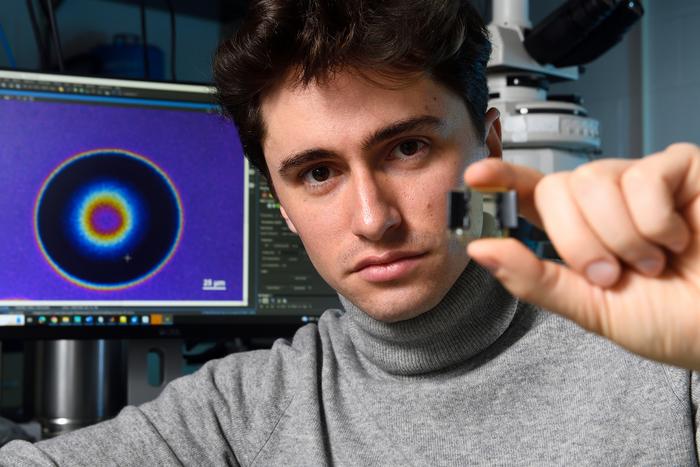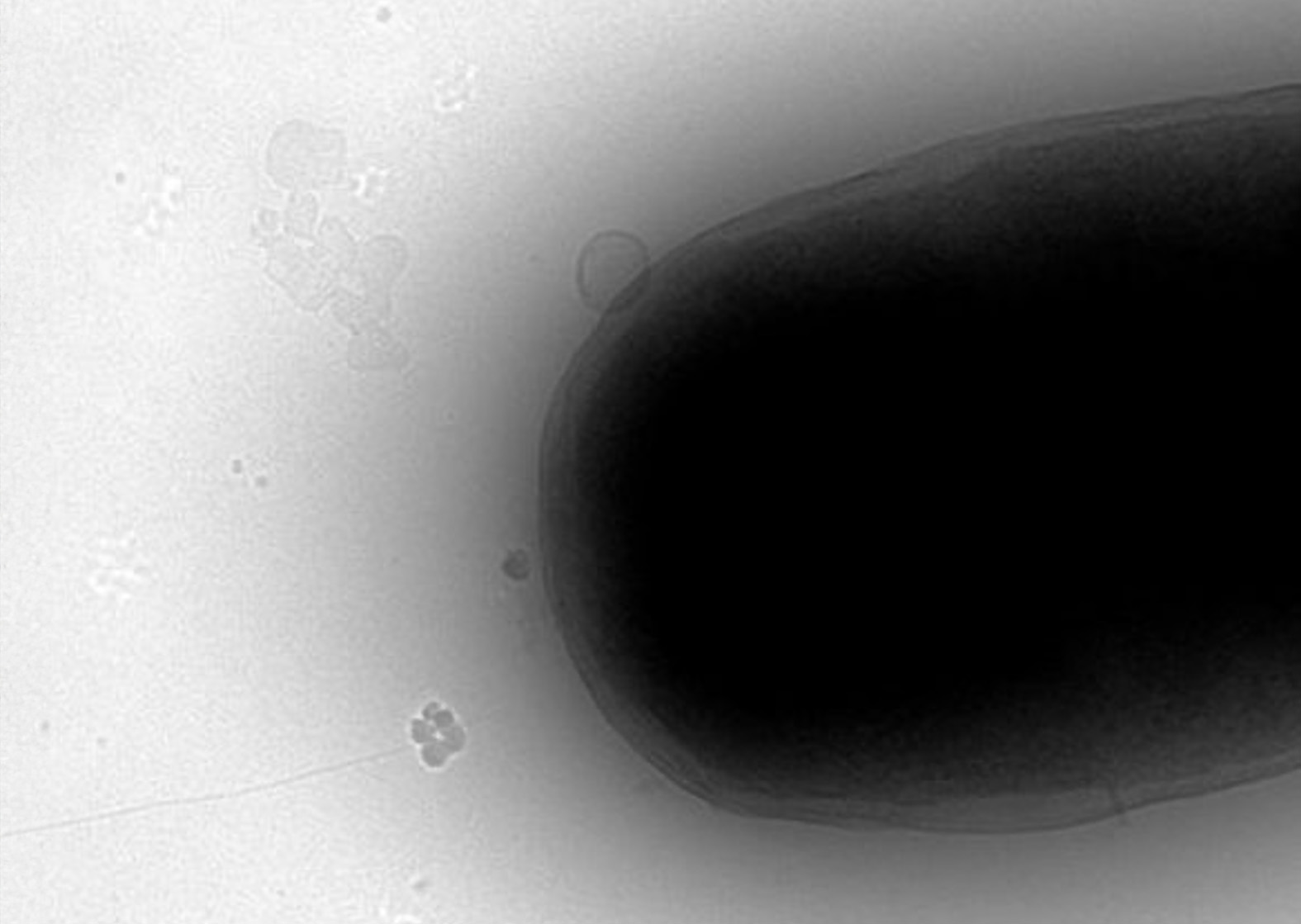
Alvin Modin with liquid crystal devices in the lab at the Krieger School of Arts and Sciences.
CREDIT: Will Kirk/Johns Hopkins University.
Robots and cameras of the future could be made of liquid crystals, thanks to a new discovery that significantly expands the potential of the chemicals already common in computer displays and digital watches.
The findings, a simple and inexpensive way to manipulate the molecular properties of liquid crystals with light exposure, are now published in Advanced Materials.
“Using our method, any lab with a microscope and a set of lenses can arrange the liquid crystal alignment in any pattern they’d want,” said author Alvin Modin, a doctoral researcher studying physics at Johns Hopkins. “Industrial labs and manufacturers could probably adopt the method in a day.”
Liquid crystal molecules flow like a liquid, but they have a common orientation like in solids, and this orientation can change in response to stimuli. They are useful in LCD screens, biomedical imaging instruments, and other devices that require precise control of light and subtle movements. But controlling their alignment in three dimensions requires costly and complicated techniques, Modin said.
The team, which includes Johns Hopkins physics professor Robert Leheny and assistant research professor Francesca Serra, discovered they could manipulate the three-dimensional orientation of liquid crystals by controlling light exposures of a photosensitive material deposited on glass.
They shined polarized and unpolarized light at the liquid crystals through a microscope. In polarized light, light waves oscillate in specific directions rather than randomly in all directions, as they would in unpolarized light. The team used the method to create a microscopic lens of liquid crystals able to focus light depending on the polarization of light shining through it.
First, the team beamed polarized light to align the liquid crystals on a surface. Then, they used regular light to reorient the liquid crystals upward from that plane. This allowed them to control the orientation of two types of common liquid crystals and create patterns with features the size of a few micrometers, a fraction of the thickness of a human hair.
The findings could lead to the creation of programmable tools that shapeshift in response to stimuli, like those needed in soft, rubberlike robots to handle complex objects and environments or camera lenses that automatically focus depending on lighting conditions, said Serra, who is also an associate professor at the University of Southern Denmark.
“If I wanted to make an arbitrary three-dimensional shape, like an arm or a gripper, I would have to align the liquid crystals so that when it is subject to a stimulus, this material restructures spontaneously into those shapes,” Serra said. “The missing information until now was how to control this three-dimensional axis of the alignment of liquid crystals, but now we have a way to make that possible.”
The scientists are working to obtain a patent for their discovery and plan to further test it with different types of liquid crystal molecules and solidified polymers made of these molecules.
“Certain types of structures couldn’t be attempted before because we didn’t have the right control of the three-dimensional alignment of the liquid crystals,” Serra said. “But now we do, so it is just limited by one’s imagination in finding a clever structure to build with this method, using a three-dimensional varying alignment of liquid crystals.”
Original Article: A key to the future of robots could be hiding in liquid crystals
More from: Johns Hopkins University | University of Southern Denmark
The Latest Updates from Bing News
Go deeper with Bing News on:
Liquid crystals
- CORRECTION: VueReal Unveils ColourFusion(TM) microDisplay: A Revolution in Augmented Reality (AR) Display Technology
WATERLOO, ON / ACCESSWIRE / May 8, 2024 / VueReal, a pioneer in MicroSolid Printing™, today announced the launch of its revolutionary ColourFusion™ microDisplay, an innovative augmented reality (AR) ...
- X-ray study offers first look at a quantum version of the liquid-crystal phase
A team of scientists, with help from Argonne National Laboratory’s Advanced Photon Source, have demonstrated the existence of an elusive state of matter known as quantum spin nematic.
- Researchers discover spontaneous liquefaction of solid metal–liquid metal interfaces in colloidal binary alloys
The boundary between solid metal and liquid metal can be much less "solid" than we ever suspected. RMIT researchers have discovered that the liquid-solid boundary can fluctuate back and forth, with ...
- The Liquid Crystal Revolution: Leading the Global Market to Greater Heights with a (CAGR) of 6.1% between 2023 and 2028
Liquid Crystal Polymers: Global Markets' is basically a report or study that looks at how liquid crystal polymers are doing all around the world. These are special kinds of materials that have some ...
- Liquid crystal-integrated metasurfaces for an active photonic platform
Schematic diagram providing an overview of this review. Liquid crystals can be categorized into nematic, smectic, columnar, and cholesteric liquid crystals. Recently, metasurfaces have been ...
Go deeper with Bing News on:
Shapeshifting programmable tools
- Advanced Tightening Tools Provide New Flexibility
Equipped with a built-in controller, the Nexo cordless nutrunner monitors and documents the fastening process without sacrificing ergonomics.
- Home tools and toolboxes
We independently review everything we recommend. When you buy through our links, we may earn a commission. Learn more› by Doug Mahoney It took hundreds of cuts and years of reader requests for ...
- Neuroscientists Discover Shapeshifting DNA Controls Memory Formation
Neuroscientists have uncovered a new mechanism for memory formation, and it involves changes in the structure of your DNA. If you were asked to picture a molecule of DNA, chances are you would ...
- Top 12 Data Migration Tools for 2024
Explore the top data migration tools to efficiently and securely transfer data to new systems or platforms. Find the best tool for your data migration needs. If you need to move, convert or ...
- 8 Best ETL Tools and Software for 2024
Databricks, AWS and Google Cloud are among the top ETL tools for seamless data integration, featuring AI, real-time processing and visual mapping to enhance business intelligence. Extract ...








